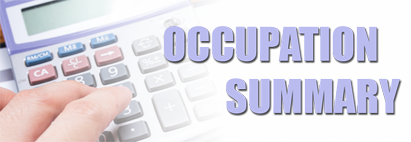The U.S. Department of Labor has developed an automated occupational information database, O*NET, that identifies and describes work content, work skills, and training requirements for all jobs across the country in all sectors of the economy. Much of the occupational information contained in this report is derived directly from the O*NET database, and supplemented with information from the Bureau of Labor Statistics, Census Bureau, and Labor Market and Career Information.

| Industry | % of Receptionists and Information Clerks employed | Annual Growth Rate |
|---|---|---|
| Offices of physicians | 17 | 0.28 |
| Offices of dentists | 8.3 | 0.70 |
| Offices of other health practitioners | 6.4 | 1.19 |
| Personal care services | 6.3 | -0.24 |
| Other professional, scientific, and technical services | 5.8 | 0.77 |
| Other amusement and recreation industries | 5 | -0.42 |
| General medical and surgical hospitals | 3.9 | 0.33 |
| Legal services | 2.6 | -0.75 |
| Outpatient care centers | 2.6 | 1.74 |
| Automobile dealers | 2.2 | -0.96 |
| Employment services | 2.2 | -0.97 |
| 2024 Statewide average hourly wage | $16.65 |
| 2024 National average hourly wage | $18.50 |
| 2022 National employment | 1,068,800 |
| 2022 Texas employment | 106,544 |
| Texas projected employment by 2032 | 117,843 |
| Texas projected annual employment and Turnover openings through 2032 | 16,028 |

| Region | Employment | Projected Employment 2032 | Projected Annual Openings 2032 |
Annual Growth Rate |
Average Income |
|---|---|---|---|---|---|
| Texas (all regions) | 106,544 | 117,843 | 16,028 | 1.01% | $34,634.00 |
| Top 10 Relevant Knowledge Areas | Relevant Importance Levels |
|---|---|
| Customer and Personal Service Knowledge of principles and processes for providing customer and personal services. This includes customer needs assessment, meeting quality standards for services, and evaluation of customer satisfaction. |
|
| Administrative Knowledge of administrative and office procedures and systems such as word processing, managing files and records, stenography and transcription, designing forms, and workplace terminology. |
|
| English Language Knowledge of the structure and content of the English language including the meaning and spelling of words, rules of composition, and grammar. |
|
| Computers and Electronics Knowledge of circuit boards, processors, chips, electronic equipment, and computer hardware and software, including applications and programming. |
|
| Mathematics Knowledge of arithmetic, algebra, geometry, calculus, statistics, and their applications. |
|
| Public Safety and Security Knowledge of relevant equipment, policies, procedures, and strategies to promote effective local, state, or national security operations for the protection of people, data, property, and institutions. |
|
| Administration and Management Knowledge of business and management principles involved in strategic planning, resource allocation, human resources modeling, leadership technique, production methods, and coordination of people and resources. |
|
| Telecommunications Knowledge of transmission, broadcasting, switching, control, and operation of telecommunications systems. |
|
| Personnel and Human Resources Knowledge of principles and procedures for personnel recruitment, selection, training, compensation and benefits, labor relations and negotiation, and personnel information systems. |
|
| Communications and Media Knowledge of media production, communication, and dissemination techniques and methods. This includes alternative ways to inform and entertain via written, oral, and visual media. |
| Top 10 Relevant Skill Areas | Relevant Importance Levels |
|---|---|
| Speaking Talking to others to convey information effectively. |
|
| Active Listening Giving full attention to what other people are saying, taking time to understand the points being made, asking questions as appropriate, and not interrupting at inappropriate times. |
|
| Service Orientation Actively looking for ways to help people. |
|
| Social Perceptiveness Being aware of others' reactions and understanding why they react as they do. |
|
| Critical Thinking Using logic and reasoning to identify the strengths and weaknesses of alternative solutions, conclusions, or approaches to problems. |
|
| Reading Comprehension Understanding written sentences and paragraphs in work-related documents. |
|
| Writing Communicating effectively in writing as appropriate for the needs of the audience. |
|
| Coordination Adjusting actions in relation to others' actions. |
|
| Monitoring Monitoring/Assessing performance of yourself, other individuals, or organizations to make improvements or take corrective action. |
|
| Time Management Managing one's own time and the time of others. |
| Top 10 Relevant Abilities | Relevant Importance Levels |
|---|---|
| Oral Expression The ability to communicate information and ideas in speaking so others will understand. |
|
| Oral Comprehension The ability to listen to and understand information and ideas presented through spoken words and sentences. |
|
| Speech Recognition The ability to identify and understand the speech of another person. |
|
| Speech Clarity The ability to speak clearly so others can understand you. |
|
| Written Comprehension The ability to read and understand information and ideas presented in writing. |
|
| Written Expression The ability to communicate information and ideas in writing so others will understand. |
|
| Near Vision The ability to see details at close range (within a few feet of the observer). |
|
| Selective Attention The ability to concentrate on a task over a period of time without being distracted. |
|
| Time Sharing The ability to shift back and forth between two or more activities or sources of information (such as speech, sounds, touch, or other sources). |
|
| Problem Sensitivity The ability to tell when something is wrong or is likely to go wrong. It does not involve solving the problem, only recognizing that there is a problem. |